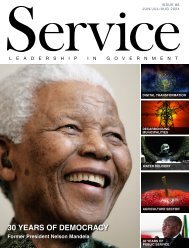Mpumalanga Business 2022-23
The 2022/23 edition of Mpumalanga Business is the 13th issue of this successful publication that since its launch in 2008 has established itself as the premier business and investment guide for the province. With messages of welcome to potential investors from both the provincial premier and the MEC responsible for Economic Development and Tourism, this edition of the journal also contains the official Mpumalanga Investment Prospectus, a comprehensive survey of the province’s assets and the potential of the region. Major catalytic projects such as the Nkomazi Special Economic Zone (NSEZ) and the Mpumalanga International Fresh Produce Market (MIFPM) are examined in detail, outlining how producers, processors and logistics firms stand to benefit and where there is potential for investment. In addition to the Prospectus, the journal contains a special feature on education and a series of brief news briefs about some of the most important sectors in the provincial economy.
The 2022/23 edition of Mpumalanga Business is the 13th issue of this successful publication that since its launch in 2008 has established itself as the premier business and investment guide for the province.
With messages of welcome to potential investors from both the provincial premier and the MEC responsible for Economic Development and Tourism, this edition of the journal also contains the official Mpumalanga Investment Prospectus, a comprehensive survey of the province’s assets and the potential of the region. Major catalytic projects such as the Nkomazi Special Economic Zone (NSEZ) and the Mpumalanga International Fresh Produce Market (MIFPM) are examined in detail, outlining how producers, processors and logistics firms stand to benefit and where there is potential for investment. In addition to the Prospectus, the journal contains a special feature on education and a series of brief news briefs about some of the most important sectors in the provincial economy.
You also want an ePaper? Increase the reach of your titles
YUMPU automatically turns print PDFs into web optimized ePapers that Google loves.
INTERVIEW<br />
Mapping for safety and<br />
economic growth<br />
Dr Taufeeq Dhansay, Manager of the Minerals and Energy Geoscience Mapping<br />
Programme, explains how important geoscientific mapping can be for every<br />
aspect of society and gives a progress report on the Council for Geoscience’s<br />
carbon capture research.<br />
Dr Taufeeq Dhansay, Manager,<br />
Council for Geoscience<br />
BIOGRAPHY<br />
After earning a bachelor’s degree in<br />
Geosciences from the University of<br />
Cape Town, Taufeeq spent time at<br />
the International Institute for Applied<br />
Systems Analysis in Austria on his way<br />
to a Master’s, where his focus was<br />
geothermal energy. Another overseas<br />
experience was at the Structural<br />
Geology and Tectonics Research Group<br />
at Jena University in Germany. Nelson<br />
Mandela University awarded Taufeeq a<br />
PhD in Geosciences in 2017.<br />
In recent mapping, what have you found in <strong>Mpumalanga</strong>?<br />
<strong>Mpumalanga</strong> is very rich is terms of its geological variety. You<br />
find some of the earth’s oldest rocks that tell you about how<br />
the earth evolved and formed. Many international scientists<br />
visit the province to investigate these rocks, some that are<br />
more than four-billion years old. You also find some of the<br />
youngest rocks, so that variety from the oldest to youngest<br />
means that you have the entire history of the earth’s processes<br />
within the province. Some of these processes include how<br />
various minerals systems formed and evolved.<br />
This implies that it is a very rich province in terms of its natural<br />
resources. This includes, coal, gold, platinum and other types<br />
of critical minerals that are needed to sustain future energy like<br />
renewable resources and batteries.<br />
Now we are looking at integrated research. What happens as<br />
we shift away from coal in the province? Does it mean that the coal<br />
was the only drawcard of the province in terms of its economy? We<br />
are finding that the answer is no.<br />
Is coal the province’s only resource?<br />
There are other mineral resources that can also be looked at. That<br />
is a primary focus at the moment. More than two thirds of the<br />
province’s economy is now reliant on coal so this brings into<br />
context the idea of the just transition.<br />
We are asking what geoscience can tell us about a transition<br />
in terms of sustainability.<br />
Coexistence between mining and agriculture only<br />
happens if you understand the geology. We have to maintain<br />
the integrity of the groundwater in such a way that you can<br />
have mining and agriculture existing perfectly in harmony.<br />
We are finding that this is possible. Secondly, if you can<br />
identify an area where you might find a fossil fuel on the<br />
surface like coal, then you can dig a bit deeper and find<br />
gas. Deeper still and you might find gold. That means that<br />
in terms of the valuation and the investment potential, the<br />
land is looked at differently, both for the GDP and for the<br />
sustainability of life in the province.<br />
MPUMALANGA BUSINESS <strong>2022</strong>/<strong>23</strong><br />
32


















